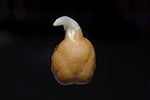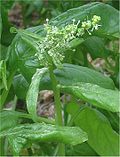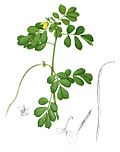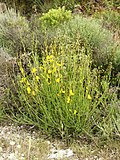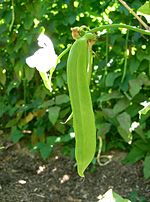Lesaffre (category Companies based in Hauts-de-France)
d'une gros se légume". L'Express (in French). Retrieved 4 March 2019. "About Us". Bio Springer. Retrieved 4 March 2019. "Visitez la fabrique de levure". Le...
6 KB (530 words) - 16:44, 4 October 2024
industry. Many legumes have Rhizobium nitrogen-fixing bacteria in nodules of their roots, which fix nitrogen from the air for the plant to use; in return...
95 KB (8,058 words) - 07:51, 19 October 2024
is a list of legume dishes. A legume is a plant in the family Fabaceae (or Leguminosae), or the fruit or seed of such a plant. Legumes are grown agriculturally...
10 KB (1,256 words) - 17:27, 5 August 2024
Plant cells are the cells present in green plants, photosynthetic eukaryotes of the kingdom Plantae. Their distinctive features include primary cell walls...
19 KB (2,224 words) - 04:45, 3 January 2024
heuningbos in Afrikaans, is a genus of some 20 species of flowering plants in the legume family Fabaceae, subfamily Faboideae. Species of the genus are native...
12 KB (1,032 words) - 06:36, 2 September 2024
animal products and high amounts of fiber-rich plant products such as vegetables, fruits, whole grains, legumes, nuts and seeds. They do not need to be vegan...
52 KB (5,660 words) - 21:47, 25 September 2024
Root nodule (redirect from Legume Root Hair Curling)
roots of plants, primarily legumes, that form a symbiosis with nitrogen-fixing bacteria. Under nitrogen-limiting conditions, capable plants form a symbiotic...
25 KB (2,627 words) - 03:23, 30 September 2024
Mimosa pudica (redirect from Sensitive plant)
touch-and-die, or shameplant) is a creeping annual or perennial flowering plant of the pea/legume family Fabaceae. It is often grown for its curiosity value: the...
39 KB (4,529 words) - 08:20, 9 October 2024
Plant nutrition is the study of the chemical elements and compounds necessary for plant growth and reproduction, plant metabolism and their external supply...
57 KB (7,336 words) - 13:52, 30 May 2024
Dioclea is a genus of flowering plants in the pea family, Fabaceae, that is native to the Americas. The seeds of these legumes are buoyant drift seeds, and...
3 KB (279 words) - 05:43, 21 April 2024
Fabaceae (redirect from Legume family)
Leguminosae, commonly known as the legume, pea, or bean family, are a large and agriculturally important family of flowering plants. It includes trees, shrubs...
62 KB (6,863 words) - 04:10, 12 September 2024
Chickpea (category Medicinal plants of Asia)
The chickpea or chick pea (Cicer arietinum) is an annual legume of the family Fabaceae, subfamily Faboideae. Its different types are variously known as...
41 KB (4,586 words) - 18:04, 2 October 2024
Vicia faba (category Medicinal plants)
as a legume, they fix nitrogen in the soil. The broad bean has high plant hardiness; it can withstand harsh and cold climates. Unlike most legumes, the...
42 KB (5,451 words) - 21:55, 14 October 2024
Botany (redirect from Plant biology)
called plant science (or plant sciences), plant biology or phytology, is the science of plant life and a branch of biology. A botanist, plant scientist...
138 KB (14,771 words) - 06:04, 1 October 2024
Phaseolus coccineus (category Plants described in 1753)
known as runner bean, scarlet runner bean, or multiflora bean, is a plant in the legume family, Fabaceae. Another common name is butter bean, which, however...
12 KB (1,180 words) - 15:22, 29 June 2024
Flowering plants are plants that bear flowers and fruits, and form the clade Angiospermae (/ˌændʒiəˈspərmiː/), commonly called angiosperms. They include...
80 KB (6,316 words) - 13:41, 23 September 2024
Spinach (category Plants described in 1753)
diversité, «L'épinard, légume de carème»" [A fabulous diversity, «Spinach, the lent vegetable»]. Petite et grande histoire des légumes [A small and great...
18 KB (1,957 words) - 01:30, 4 October 2024
Seventeen elements or nutrients are essential for plant growth and reproduction. They are carbon (C), hydrogen (H), oxygen (O), nitrogen (N), phosphorus...
68 KB (7,522 words) - 13:35, 30 September 2024
fixation as a non-legume. In this case it is customary to mention these species as a separate genus Parasponia. Trema orientale is widely planted for land reclamation...
8 KB (708 words) - 20:57, 25 May 2024
Senna tora (redirect from Sickle Wild Sensitive Plant)
obtusifolia. Senna tora (originally described by Linnaeus as Cassia tora) is a plant species in the family Fabaceae and the subfamily Caesalpinioideae. Its name...
9 KB (1,183 words) - 13:26, 23 October 2023
Mung bean (category Plants described in 1753)
The mung bean or green gram (Vigna radiata) is a plant species in the legume family. The mung bean is mainly cultivated in East, Southeast and South Asia...
51 KB (5,766 words) - 16:05, 28 September 2024
Bauhinia variegata (category Garden plants of Asia)
Bauhinia variegata is a species of flowering plant in the legume family, Fabaceae. It is native to an area from China through Southeast Asia to the Indian...
10 KB (991 words) - 14:47, 19 September 2024
Pigeon pea (category Edible legumes)
Malay word katjang (modern spelling: kacang) meaning legume in reference to the bean of the plant. In English they are commonly referred to as pigeon pea...
54 KB (4,947 words) - 19:56, 12 August 2024
Saraca asoca (category Vulnerable plants)
as the ashoka tree (lit. "sorrow-less"), is a plant belonging to the Detarioideae subfamily of the legume family. It is an important tree in the cultural...
9 KB (1,033 words) - 02:46, 30 July 2024
Spartium (category Garden plants of Europe)
legumes (seed pods) mature black and reach 8–10 cm (3–4 in) long. They burst open, often with an audible crack, spreading seed from the parent plant....
12 KB (1,213 words) - 01:21, 31 July 2024
the three actinorhizal plant orders, as well as the order fabales. The most well-known nitrogen fixing plants are the legumes, but they are not classified...
20 KB (1,948 words) - 18:39, 27 April 2024
Vigna aconitifolia (category Edible legumes)
many soil types, and can also act as a pasture legume. Moth bean is a creeping annual herbaceous plant which grows to approximately 40 cm high. Yellow...
11 KB (1,586 words) - 23:08, 16 January 2024
Canavalia gladiata (category Edible legumes)
gladiata, the sword bean or scimitar bean, is a domesticated plant species in the legume family Fabaceae. It is used as a vegetable in interior central...
2 KB (106 words) - 13:34, 12 November 2023
Galega officinalis (category Medicinal plants of Africa)
commonly known as galega or goat's-rue, is a herbaceous plant in the subfamily Faboideae of the legume family Fabaceae. It is native to parts of northern Africa...
9 KB (843 words) - 15:22, 8 October 2024











